Issue #114, Volume #2


Freeing Up So Much Value That Making 25x Is Almost Inevitable
This is Porter’s Daily Journal, a free e-letter from Porter & Co. that provides unfiltered insights on markets, the economy, and life to help readers become better investors. It includes weekday editions and two weekend editions… and is free to all subscribers.
| Japan trades at a huge discount… More upside to come… Owning the most valuable technology ever created… A crypto war chest worth multiples of its market cap… No one knows that it’s there… Three key catalysts… Alternative jobs reports also bad news… Hyperscalers pour on the capex spending… |
There’s a better path.
I’ve been explaining in the last two Daily Journals that investing doesn’t have to be risky. You don’t have to depend on a series of ifs or whens. You don’t need to gamble on coulds or shoulds.
If you’re willing to look carefully, there’s a much safer path. It’s the path Warren Buffett took in his early days, when he was compounding his wealth at greater than 50% a year.
(Again, I’d urge you to read Brett Gardner’s stunningly brilliant book, Buffett’s Early Investments. Gardner doesn’t just tell the same old and tired Buffett tales. He dissects Buffett’s largest early investments and shows readers exactly how to make life-altering fortunes – not by hoping for growth but by buying undeniable value at a fraction of its worth. Brett Gardner’s Buffett’s Early Investments inspired me to find situations in today’s markets that are just as attractive as the investments featured in the book.)
Today’s Journal is longer and more explicit than normal. We don’t typically give away our most valuable investment research in these pages. But I’m doing so today because I want to prove to you that “unbelievable” opportunities are very real.
Investors are in the midst of unlocking so much value from Japanese businesses that making something like 25x your money in this market over the next decade is almost inevitable.
Japanese trading houses like Mitsubishi and Itochu trade at huge discounts to their total assets, much like the Philadelphia & Reading Corporation did back in 1955, before Buffett made it his largest investment ever. And guess who is buying these stocks? Warren Buffett, of course. He’s invested almost $5 billion into five of these huge conglomerates, an investment that has already grown by almost 6x.
There is far more upside to come, as structural reforms to increase return on equity (“ROE”) have barely begun. And… there’s one major difference between Buffett’s Philadelphia & Reading investment 70 years ago and today’s Asian conglomerates. In Asia, the balance sheets are not loaded with worthless coal mines. Instead, investors can own some of the most valuable technology that’s ever been created.
Let me explain one of them: Ripple.
Launched in 2012 by Ripple Labs (founded by Jed McCaleb, Arthur Britto, and David Schwartz), Ripple is a system built to facilitate virtually instant, secure interbank transfers. At the core of the system is the XRP Ledger, which is a decentralized, open source, blockchain. It can handle enormous transaction loads (1,500 transactions per second), offering virtually free settlement in three to five seconds. This is comparable to Visa’s network, which is considered the world’s best proprietary payments network. And compared to the existing SWIFT network, Ripple is a miracle.
Thus, Ripple’s token, XRP, is not a meme coin. It’s the coin of the realm for the future of payments. JPMorgan, PNC Bank, MoneyGram use it in the U.S. Santander Bank and Standard Chartered use it abroad. And as the stablecoin revolution transforms banking and payments, Ripple’s XRP Ledger will become the new standard rail gauge for payments.
For investors, Ripple’s token (XRP) holds another, unique advantage. Unlike Bitcoin, which continues to be mined but isn’t consumed, all of the XRP that will ever be created has already been mined. XRP tokens are what fuel the XRP Ledger. Tokens are “burned,” as the price for access. Every transaction on the XRP Ledger incurs a tiny base fee (currently 0.00001 XRP), which are automatically destroyed. Thus, over time, the total supply of Ripple’s XRP token will decline, creating more and more value for the token’s holders.
To prevent XRP from flooding the market, in December 2017, Ripple Labs locked 55 billion XRP tokens (about 55% of the total supply) into a series of 55 smart-contract escrows. This built predictability into the supply by scheduling controlled releases. The system unlocks 1 billion XRP each month, but Ripple typically re-escrows 700 million to 800 million of it, using the remainder for operations, partnerships, and market-making.
As of October 1, circulating XRP supply stands at about 56 billion, with total burned now exceeding 12 million – a modest 0.012% nibble. But the mechanism is just warming up. At current volumes (1 million to 2 million tokens per day), burns equate to 0.001% to 0.002% annually… Almost nothing.
But consider what will happen if Ripple scales and becomes the institutional standard. The compounding? Exponential. As supply shrinks, each remaining XRP captures more of the network’s value. Unlike inflationary tokens, XRP aligns incentives: users pay for efficiency, holders gain scarcity.
And guess who owns the largest stash of Ripple tokens in the world…? A forgotten Japanese financial conglomerate.
SBI Holdings (TSE: 8473), a ¥2.08 trillion ($14 billion) Japanese financial holding company. (Hat tip to Tech Frontiers editor Erez Kalir, who first brought this to our attention.) It looks like a “boring” financial-services firm. But it’s hiding a crypto war chest worth multiples of its market cap. SBI isn’t a bet on ifs. It’s $1 for 20 cents.
SBI Holdings started as a sleepy online brokerage in 1999, but under CEO Yoshitaka Kitao (think Philadelphia & Reading’s Mickey Graham) it has ballooned into a financial powerhouse.
Today, its core financial services business (83% of revenue) spans securities brokerage (a Japanese Schwab/Fidelity hybrid), regional banking via SBI Shinsei, asset management, and insurance (life, property, casualty). These lines synergize beautifully: a brokerage client morphs into a bank borrower, then an insurance buyer. It’s a flywheel of cross-sells.
In fiscal 2024 (ended March 31, 2025), SBI recorded record revenue of ¥1.44 trillion, up 19.3% year-over-year. That was good enough for a five-year compound annual growth rate of 26%. Profit attributable to owners? ¥162.1 billion, up 85.8%, with ROE at 12.8%. That’s tops among peers: Nomura’s 10.0%, Daiwa’s 9.8%, SMBC Nikko’s 5.5%, Mitsubishi UFJ Securities’ 6.1%.
Yet the stock ($14 billion market cap) trades at a trailing P/E of only 12.6x.
But that’s not why you should invest in it. Buried in SBI’s “Crypto-Asset Business” (6% of revenue, but 8% of profits) lies an enormous hidden asset.
In 2016, CEO Kitao partnered with Ripple Labs, forming SBI Ripple Asia, to establish XRP as Asia’s cross-border payment standard.
SBI became Ripple’s largest external shareholder (8% to 9% stake) and scooped up a massive XRP hoard.
Exact figures are opaque, but disclosures peg SBI’s combined Ripple equity and XRP holdings at a minimum of $10.7 billion – an amount equal to 76% of its entire market cap. These disclosures, however, are based on acquisition cost, not current market value. We know that SBI owns at least 3.4 billion XRP tokens, based on its 8% ownership of Ripple’s 42 billion escrow account. At $3.04 (October 3 price), that’s $10.3 billion in tokens alone.
Include Ripple Lab’s private valuation (around $15 billion post-funding) and that adds another $12 billion to SBI’s asset pile. Or, in other words, SBI’s hidden Ripple Holdings investment and XRP holdings are worth 50%+ more than its existing market cap.
And these assets are likely to become vastly more valuable. Projections vary, but if XRP hits Visa-scale volumes (65,000 transactions per second peak), burns could erase 1 billion to 2 billion tokens annually, pushing the value of the remaining tokens considerably higher.
In addition to its intrinsic value, consider this list of major catalysts that I believe will propel the value of Ripple Labs and XRP tokens much higher over the next year.
- Approval of XRP ETFs: Several major ETF filers, including SBI’s own joint ventures, have applications pending with the Securities And Exchange Commission (“SEC”) and Tokyo Stock Exchange. Approval would open XRP exposure to trillions in global assets under management.
- Japanese Bank Adoption: Over 80% of Japanese institutions are slated to begin large-scale use of Ripple’s payment platform and XRP for remittances in 2025-2026 – the move is championed by Japan’s FSA and dovetails with a national push to digitize payments infrastructure.
- Stablecoin Launch and U.S. Listing: Ripple’s RL/USD stablecoin launch will cement XRP as the bridge currency for global stablecoin clearing – plans for a U.S. ADR or direct listing (as suggested by activist campaigns) would also increase SBI’s global profile and liquidity.
The Japanese bank adoption is the most important benchmark. If that happens, it will make the XRP Ledger the de-facto replacement for SWIFT.
I like to think of SBI Holdings as an inverse Philadelphia & Reading. Instead of a balance sheet full of worthless coal mines, SBI has a balance sheet filled with untapped “coal” mines.
And the mining is just beginning.
If you think this investment idea sounds good, wait until you see what’s in our next issue of The Big Secret On Wall Street. It’s the largest opportunity in Japan… and it’s worth 5x to 10x its current market cap. Oh, it’s also the safest investment I’ve ever seen.
If you’re not yet a paid-up subscriber to The Big Secret On Wall Street, click here now to learn more.
“Forget AI,” Says Reagan’s #1 Futurist
Presented by Banyan Hill Publishing
While everyone’s chasing the same AI plays, George Gilder is focused on something completely different.
He says a 4-nanometer device that’s 80 MILLION times more powerful than the chip he gave Ronald Reagan is now being made in America for the first time.
And he’s identified three companies that control this technology.
Click here to get the details before this BOMBSHELL announcement changes everything.
Three Things To Know Before We Go…
1. Trump proposes “tariff dividends.” President Donald Trump said yesterday that he is considering returning to taxpayers some of the tariff revenue his administration has collected – in the form of rebate checks of up to $2,000 – after first paying down some of the federal debt. We can’t speak to the feasibility of such a move – but simple math would suggest these stimulus checks would consume most, if not all, of the estimated $220 billion collected in tariffs to date. However, recent history suggests sending Americans direct payments of this size would be highly inflationary and would likely push the price of gold and Bitcoin (and other assets) much higher.
2. Alternative jobs data reveals a sluggish labor market. The federal government shutdown prevented the Bureau of Labor Statistics (“BLS”) from issuing the September payroll report this morning. However, alternative data sources point toward a weakening labor market. This includes America’s largest payroll processor, ADP, which reported a decline of 32,000 jobs last month. Likewise, jobs-posting website Indeed.com reported a 2.5% drop in job listings in September. Employment analytics firm Revelio reported an uptick of 60,000 jobs in September – a number that is still well below the 150,000 to 200,000 monthly hiring rate considered healthy for the U.S. labor market.
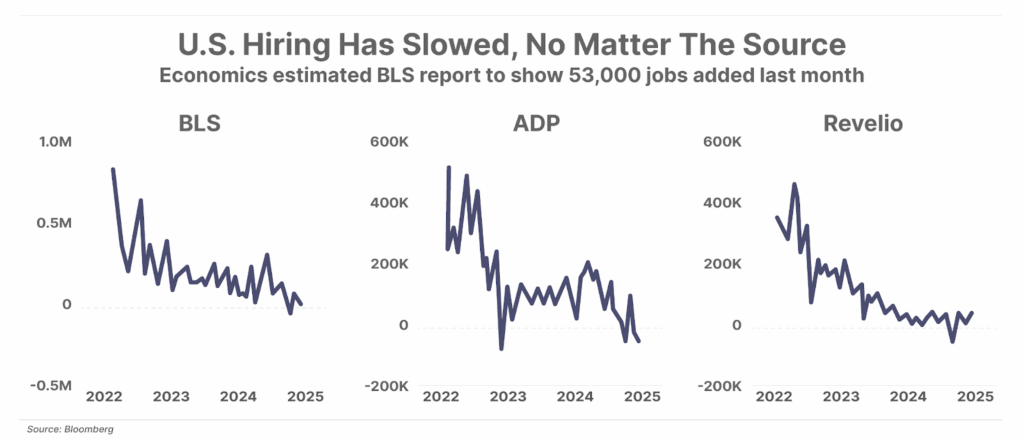
3. Private credit is running dry. Private credit funds, which Marty Fridson wrote about this summer, now take 23 months to raise money – almost double the pace of 2021. Pensions are tapped out, stuck in private-equity deals with no exits and no liquidity. The biggest credit funds are turning to private wealth as the new source of funding. Smaller funds are struggling even more, taking 25 months to raise capital – relying less on seasoned institutions and more on second-tier investors. As a result, the cracks are beginning to show – First Brands, a car appliance maker just filed for bankruptcy, and its debt now trades at 36 cents on the dollar, dragging private credit funds down with it.
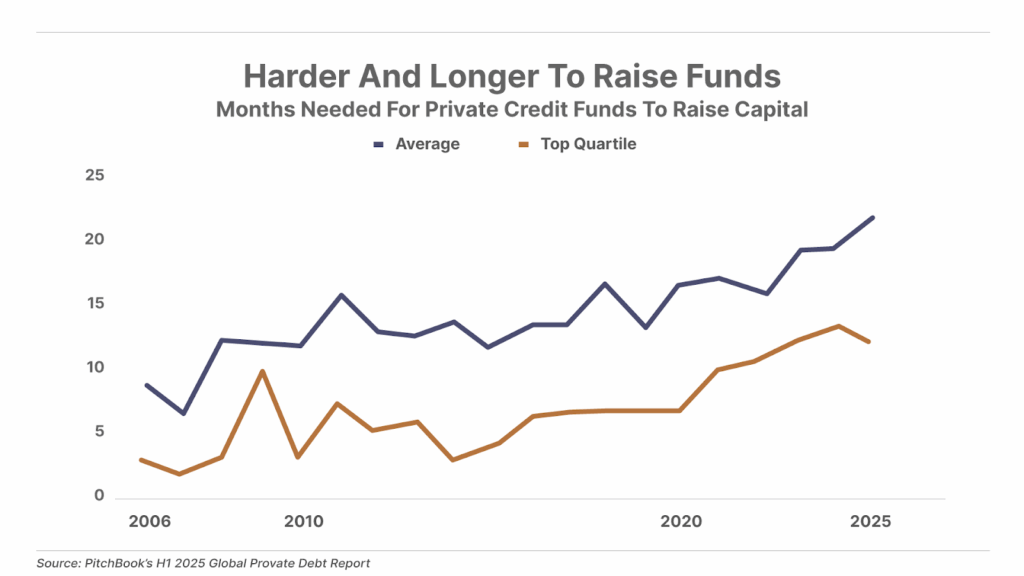
And One More Thing… AI Spending Shows No Signs of Slowing
The five major artificial intelligence (“AI”) hyperscalers – Alphabet (GOOG), Amazon (AMZN), Meta Platforms (META), Microsoft (MSFT), and Oracle (ORCL) – have spent more than $500 billion on AI capital expenditures over the past few years. However, according to JPMorgan analysts, these same firms are likely to spend more than double that amount – another $1.2 trillion – through 2027.
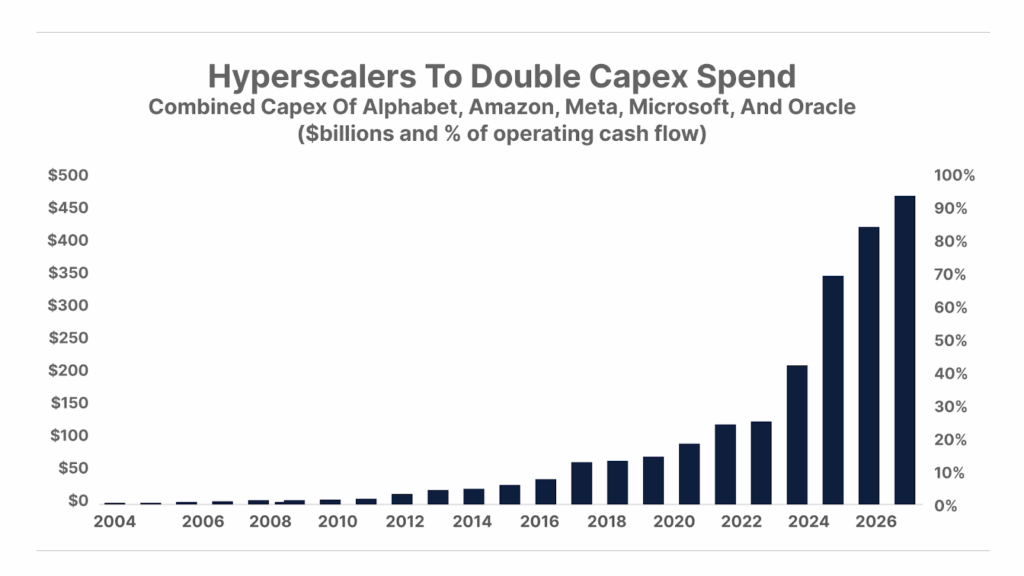
Tell me what you think of today’s Daily Journal or anything else: [email protected]
Good investing,
Porter Stansberry
Stevenson, Maryland
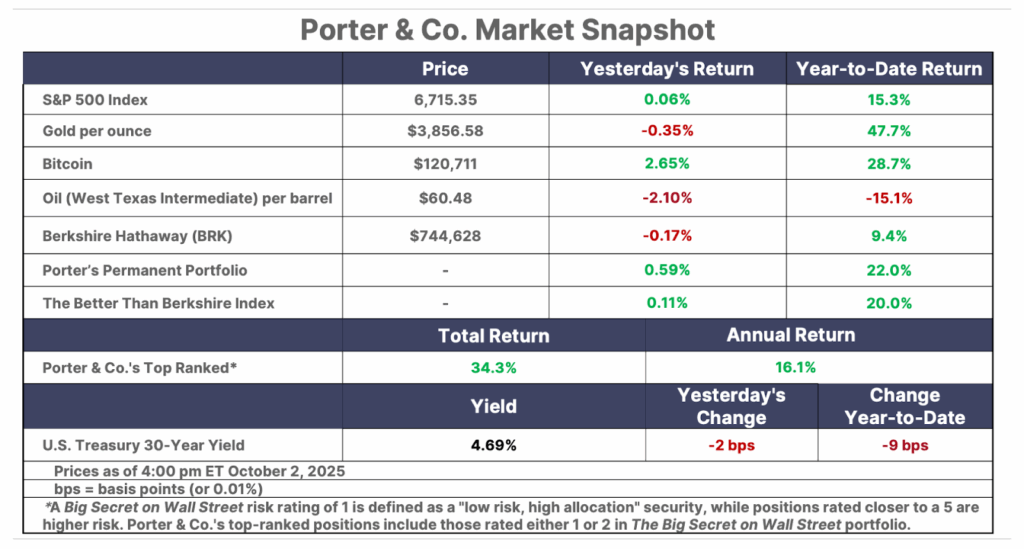
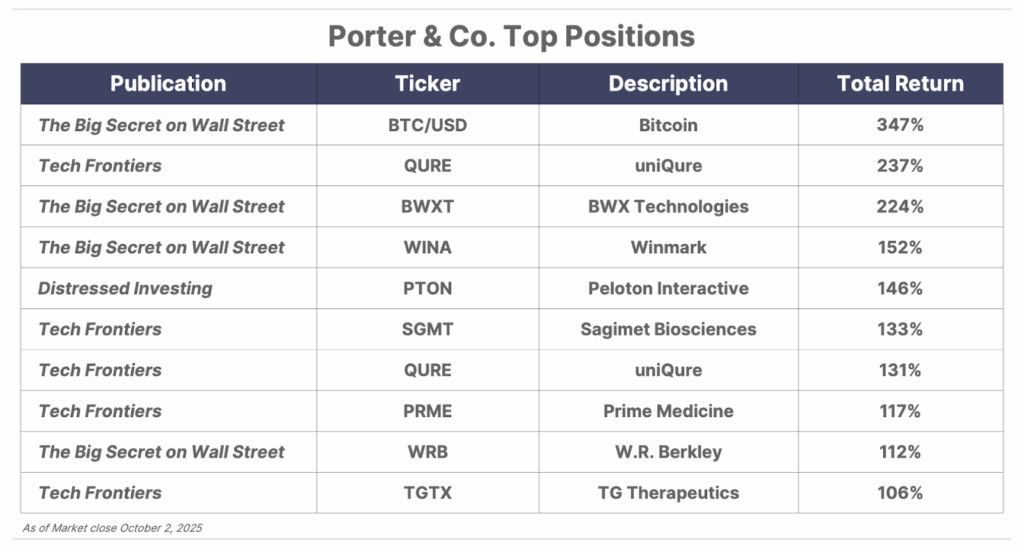
Please note: The investments in our “Porter & Co. Top Positions” should not be considered current recommendations. These positions are the best performers across our publications – and the securities listed may (or may not) be above the current buy-up-to price. To learn more, visit the current portfolio page of the relevant service, here. To gain access or to learn more about our current portfolios, call our Customer Care team at 888-610-8895 or internationally at +1 443-815-4447.
